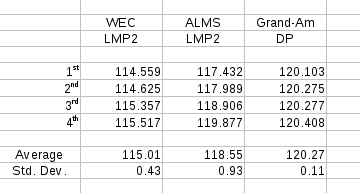This is both the first and last time the ALMS will run at COTA. While the GTE cars and the LMPC cars in the ALMS will be running largely unchanged next year the United SportsCar Racing Championship series sponsored by Tudor watches (aka TUSCC, pronounced "tusk"), the LMP2 cars will be combined with the Daytona Prototypes from Grand-Am into a single class. The COTA races permit a comparison of those cars from the WEC, ALMS and Grand-Am on the same track.
Here is a summary of the fastest race laps (time in seconds) for the top four cars in each series (for LMP2 and DP):
The results are somewhat surprising. The first thing that stood out to me was the difference between the WEC and ALMS LMP2 cars. I would have expected them to be much closer instead of nearly 3 seconds apart. I also expected the ALMS cars to be significantly faster than the DPs, and while nearly 2 seconds is far from nothing, I would have predicted a better showing from the ALMS LMP2. So my first question was:
Why is there such a difference between the WEC and ALMS lap times?
Part of the answer is probably because the WEC LMP2 class runs on bespoke Dunlop tires (one car, Pecom Racing is on bespoke Michelins), while the ALMS class is on off-the-shelf Michelins. According to Ryan Dalziel, this can make quite a difference. Another part of the answer is that, while the race was run in dry conditions, rains prior to the ALMS race prevented the track to "rubber-in" sufficiently to permit maximum performance. Even the ALMS qualifying was run in the wet. The WEC qualifying and race were in dry conditions and benefited from the ALMS race seasoning the track. There is also one other obvious difference between the LMP2 cars in WEC and ALMS: All 4 LMP2 cars in the ALMS are HPD/Honda while none of the WEC cars are that configuration. Would these factors explain the entire 2 second difference between WEC and ALMS? Maybe, but we'll never know.
What about the small performance difference between ALMS/LMP2 and Grand-Am/DP?
Part of the answer may lie in the weather. Grand-Am had their race much earlier in the year when conditions were likely much better:
The temperatures are the daily high for Austin, Texas from the Weather Underground Weather and History Almanac (www.wunderground.com).
The 24-25F degree difference in ambient temperature very likely had an effect on performance, tire wear and driver fatigue. Looking at days prior to the race dates indicate that Grand-Am also had dry weather to prepare for the race, unlike the ALMS.
The 2014 Season
Sadly, next year there will be no ALMS. We will however be able to see the TUSCC and WEC at Cota the same weekend next September. The TUSCC race is on the 20th and the WEC race is on the 21st. By then hopefully we will know what BoP measures have been applied to LMP2 and DP in the TUSCC Prototype Class and be able to more directly compare them to the WEC teams. Of course the best comparison would have been to have them in the same race.


No comments:
Post a Comment